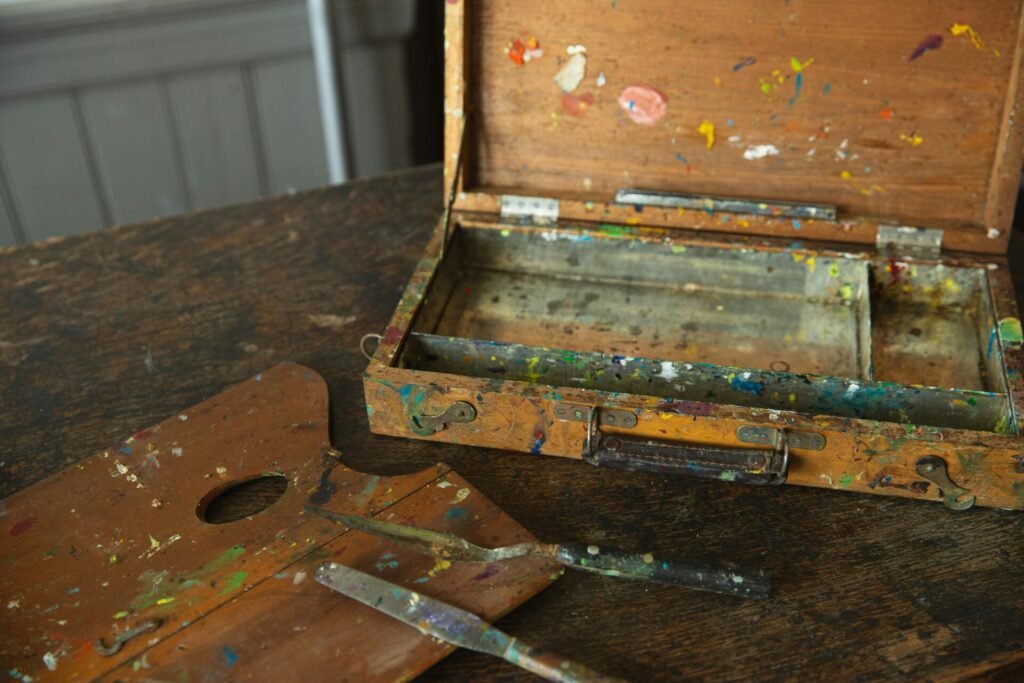Why the Right Toolbox Matters
Every artist needs a reliable way to store, organize, and transport their tools. Whether you’re a painter, illustrator, sculptor, or mixed media enthusiast, the right toolbox can make your creative process smoother and more enjoyable. In this guide, we’ll explore the types of artist toolboxes available, what to look for when choosing one, and how to match your toolbox to your artistic workflow.
An artist’s toolbox isn’t just a container—it’s a mobile studio, a storage solution, and a reflection of how you work. A well-chosen toolbox protects your materials, saves time during setup and cleanup, and helps you stay focused on creating rather than searching for supplies.
Whether you’re working in a home studio, plein air painting in the field, or commuting to classes, your toolbox should support your rhythm and routine.
Common Types of Artist Toolboxes
Portable Plastic Toolboxes
These are the most accessible and widely used toolboxes for artists. Modeled after hardware toolboxes, they often feature a sturdy handle, snap closures, and removable trays.
Best for: Beginners, students, and hobbyists who need a lightweight, affordable option.
Pros:
- Durable and water-resistant
- Easy to clean
- Available in various sizes and colors
Cons:
- Limited customization
- May not fit larger or oddly shaped tools
Wooden Artist Boxes
Wooden toolboxes offer a classic, professional look and are often used by painters and illustrators. Many include compartments, brush holders, and palette storage.
Best for: Oil and acrylic painters, traditional illustrators, and artists who value aesthetics and craftsmanship.
Pros:
- Elegant and durable
- Often includes built-in easels or palette trays
- Great for studio or plein air use
Cons:
- Heavier than plastic
- Can be more expensive
Rolling Art Carts and Trolleys
These wheeled toolboxes are ideal for artists with a large collection of supplies or those who work in shared or mobile studio spaces.
Best for: Mixed media artists, teachers, and creatives who need to move their setup frequently.
Pros:
- High capacity and easy mobility
- Multiple drawers and compartments
- Great for organizing by medium or project
Cons:
- Bulky and not ideal for travel
- Requires more storage space
Modular Storage Systems
These stackable, customizable systems allow artists to build their own toolbox layout. They often include clear bins, drawers, and trays.
Best for: Artists who want to tailor their storage to specific tools or projects.
Pros:
- Highly customizable
- Easy to expand as your collection grows
- Great for studio organization
Cons:
- Not very portable
- Can become expensive with add-ons
Sketchbooks.org | VISUAL RESEARCH HUB
Artist Toolboxes
Visual research is critical for any creative endeavor. We have compiled specialized links to lead you directly to images, videos, and inspiration for "Artist Toolboxes" across the web's best visual search platforms.
Soft-Sided Art Bags and Totes
These fabric-based toolboxes are lightweight and flexible, often with multiple pockets and compartments.
Best for: Sketchbook artists, urban sketchers, and watercolorists on the go.
Pros:
- Lightweight and easy to carry
- Can fit odd-shaped items like sketchbooks or brush rolls
- Often includes shoulder straps or backpack options
Cons:
- Less protective than hard cases
- May wear out faster with heavy use
Specialty Toolboxes by Medium
Some toolboxes are designed specifically for certain art forms:
- Brush boxes: Long, narrow cases for protecting paintbrushes
- Pencil cases: Roll-up or zippered pouches for colored pencils or graphite
- Calligraphy kits: Compartmentalized boxes for nibs, ink, and holders
- Sculpting tool rolls: Fabric wraps with slots for carving tools
These are ideal for artists who want to keep tools grouped by function or medium.
What to Look For in an Artist Toolbox
Size and Capacity
Choose a toolbox that fits your current tools with room to grow. Consider the size of your brushes, sketchbooks, paints, or sculpting tools. A toolbox that’s too small will frustrate you; one that’s too large may be cumbersome.
Material and Durability
Plastic is lightweight and water-resistant, while wood offers a more refined, durable feel. Fabric bags are flexible and portable but may not protect fragile items. Choose based on your environment and how rough you are on your gear.
Compartments and Organization
Look for trays, dividers, or modular inserts that help you separate tools by type or project. A cluttered toolbox slows you down and increases the risk of damage.
Portability
If you travel or work outside your studio, prioritize handles, straps, or wheels. For studio-only use, focus on capacity and layout.
Aesthetic and Personal Style
Your toolbox is part of your creative identity. Whether you prefer a sleek black case, a vintage wooden box, or a colorful tote, choose something that inspires you to open it up and get to work.
Matching Your Toolbox to Your Creative Practice
- Painters: Look for boxes with brush holders, palette storage, and space for tubes or jars.
- Sketchbook artists: Choose soft-sided bags with compartments for pens, pencils, and a portable sketchbook.
- Mixed media artists: Opt for modular or rolling systems that can handle a variety of tools and materials.
- Digital artists: Consider a tech-friendly case with space for styluses, chargers, and sketchbooks.
- Sculptors: Use tool rolls or hard cases with foam inserts to protect sharp or delicate tools.

Sketchbooks.org | NEW TECHNIQUES
Using Watercolor and Pen | Modern Sketchbook Techniques
In this post, we’ll explore modern sketchbook techniques using watercolor and pen, offering practical insights and creative inspiration for artists at any level. Sketchbooks have evolved far beyond their traditional role as practice pads for...
Frequently Asked Questions
What size toolbox should I get?
Choose one that fits your most-used tools with a little room to grow, but not so large that it becomes unwieldy.
Are wooden toolboxes better than plastic ones?
Wooden boxes are more durable and elegant, while plastic ones are lighter and more affordable—choose based on your needs.
Can I use a regular toolbox from a hardware store?
Yes, many artists repurpose hardware toolboxes, especially for durability and affordability.
What’s the best toolbox for travel or plein air painting?
Look for lightweight wooden boxes with built-in easels or soft-sided bags with shoulder straps.
How do I organize my toolbox efficiently?
Group tools by function or medium, use dividers or trays, and regularly clean out unused items.
Do I need different toolboxes for different mediums?
Not necessarily, but having separate storage for different media can help keep your workflow organized.
Are rolling carts good for small studios?
Yes, especially if you need to move supplies between rooms or store them compactly when not in use.
Final Thoughts
Choosing the right types of artist toolboxes is about more than storage—it’s about supporting your creative process. Whether you’re a minimalist sketcher or a mixed media maximalist, the right toolbox helps you stay organized, inspired, and ready to create.
Think of your toolbox as a creative companion: it should reflect your style, meet your needs, and grow with your practice. So take the time to find one that fits—not just your tools, but your artistic life.
Ready to Share Your Work?













